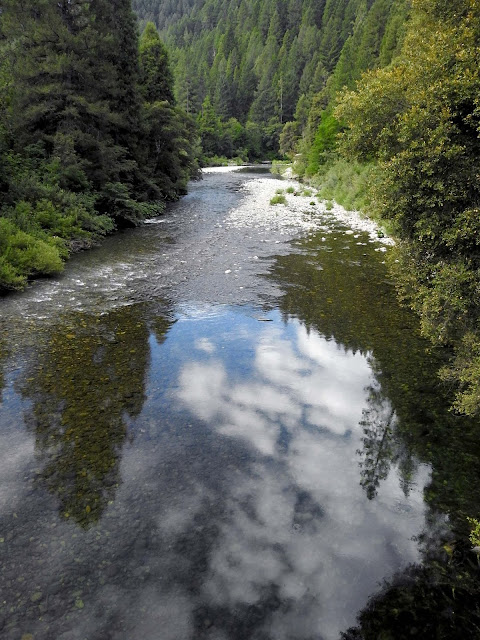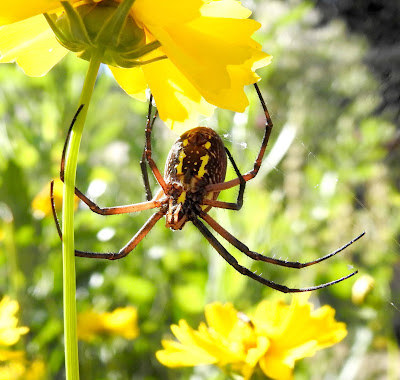After 10 days of heavy smoke, the sky finally cleared briefly on Thursday morning! We were even able to see clouds again! The smoke was back a few hours later, but the forecast is for sunny skies starting this Saturday. The heavy thundershowers and lightning that were predicted for this past Tuesday, didn't really materialize. We got a few sprinkles of rain instead! Thanks goodness! We don't need anymore lightning! There are still hundreds of fires burning in California, but the two closest to us are essentially extinguished. My sister's home isn't in any danger, although that fire is still going strong. Whew! What's scary is that this is JUST the beginning of the fire season. We still have 2 or more months to go before it will be over. I just hope for rain, without lightning, every day, all day. Thanks again to the firefighters who have been battling these blazes and putting their lives on the line!
Rain drops dotted the river rocks!
Scarlet Monkeyflower - Mimulus cardinalis
Neighborhood News!
Among the river rocks the Scarlet Monkeyflowers are still blooming! I find this amazing, since I first saw them blooming on June 22, more than 2 months ago! They are such a brilliant contrast to the surrounding greenery!
Bouncing Bet/ Soapwort - Lady's Thumb
Saponaria officinalis - Persicaria maculosa
Two non-native, invasive plants are also thriving among the river rocks, Bouncing Bet and Lady's Thumb. Bouncing Bet/Soapwort has long been used as a cleansing agent, as the roots contain a lather that serves as a soap substitute. The deer will not eat it. Apparently its name comes from buxom barmaids shaking the plants in a bottle to create suds. Was it the barmaids or the plants that were bouncing? Hmmm...
The Lady's Thumb is so called, because of a dark green splotch on the leaves, which supposedly resembles a lady's thumb! Now THAT takes a stretch of the imagination! I would have named it "Pink Pearls" or something like that. I am, however, glad that the plant name wasn't named "Lady's Thumb" after its flowers, because that would had to have been inspired by a rather sore, diseased, and distressed thumb!
Mallard (juveniles?) - Anas platyrhynchos
New this week, I spotted a group of 6 juvenile Mallards on the river! They aren't commonly seen here, but I have seen them in the past during the Fall. The Canada Geese and the Common Mergansers have joined with others of their own species, and are currently in groups of 14 Geese and 13 Mergansers! They could be large groups of juveniles, or molting adults, or juveniles and adults together. I'm not sure what is going on!
Great Blue Heron (juvenile - adult) - Ardea herodias
I've been seeing 2 Great Blue Herons on the river lately, and only just realized that one was a juvenile! The overall dark gray head and streaky breast indicate that it is a juvenile! So now my question is if Great Blue Herons nest in colonies, where did this juvenile come from? The Cornell Ornithology site states, "Juveniles tend to wander in late summer." I need to do some research and find out where this juvenile was possibly born.
Northern Flicker (juvenile, male) - Western Tanager (juvenile)
Colaptes auratus - Piranga ludoviciana
Lately I've seen a fair number of juvenile birds! The Northern Flicker will probably live here year-round, unless there is too much snow on the ground. If it can't find food to eat, it will migrate to the foothills where snowfall is typically little to none.
The juvenile Western Tanager will migrate to southern Mexico or Central America for the winter. They will start leaving our area within the next week or two! They are so colorful for juveniles! Just beautiful!
Black-throated Gray Warbler - Bushtit
Setophaga nigrescens - Psaltriparus minimus
I've also seen two flocks of little birds in the trees lately. One was a flock of Black-throated Gray Warblers! At first I thought these were Mountain Chickadees, but after looking at the photos, I realized they were warblers! I'd only seen one of these before, just last spring. These are little birds (5" long) and usually breed in Pinyon Pine/mixed pine woodlands, with brushy undergrowth, although sometimes in mixed conifer/oak woodlands. They may have bred on the east side of the Lakes Basin, where there are Pinon Pines. They eat mainly small caterpillars and insects that they glean from leaves. They have already started on their migration down to southern Mexico for the winter. They probably just stopped by to forage for food on the way!
The other flock was a group of tiny Bushtits! Apparently these tiny birds (4.5" long) live all over California except for the desert and high mountain areas. For the most part, they breed and nest in brushy habitats such as chaparral, residential areas, and second growth forests. Their nests are an unmistakable, long (6"-12"), sock-like nest made out of spider webs, lichen, and plant parts! I've never seen one of their nest in our area, even though it is possible they breed here. Their breeding season is over, so they are probably just here temporarily, foraging for insects and spiders!
Columbian Black-tailed Deer - Odocoileus hemionus columbianus
I've seen Columbian Black-tailed Deer fairly often in my neighborhood lately. The Mountain Lions must not be around! They're almost always foraging on vegetation. They always see me way before I see them. They must have keen hearing and sight, coupled with a well developed sense of smell!
Coastal Rainbow Trout - Onchoryhncus mykiss irideus
The most common species of fish in the North Yuba River is the Coastal Rainbow Trout, which are native to California, but have been planted locally. On Monday, June 23 the California Department of Fish and Wildlife planted 3,000 lbs. of rainbow trout into the North Yuba River at Downieville! I finally got a photo of one this week! They are super camouflaged, because they have a LOT of predators!
Rufous Hummingbird feeding on Anderson Thistle
Selasphorus rufus - Cirsium andersonii
Revisiting the Hummers Thistle Patch!
On Monday, August 17th, before the smoke enveloped our area, I revisited the patch of Anderson Thistles where dozens of Rufous Hummingbirds feed. Luckily, the thistles were still blooming and the hummers were still feeding! My husband and I had initially visited this area two weeks before. To my delight, dozens of hummers were still chattering away as they flew, hovered, and fed in the thistle patch. It is truly one of the most beautiful sights I have ever seen! This must be one of their favorite stopovers on their migration south to their winter grounds in southern Mexico!
Red Mound Ants and Aphids on Anderson Thistle
Formica integroides - super family Aphidoidea - Cirsium andersonii
As I walked around and observed the hummers, I found a thistle that had red ants on it! There was only one of them like this. As I looked closer, I realized that there were aphids on the thistle as well. The Red Ants were probably "milking" the aphids for the "honeydew" that they excrete!!!
Anderson Thistle going to seed!
Cirsium andersonii
I also came across this GORGEOUS thistle head that had started to go to seed. I was astounded by its delicately colored beauty! Wow! I am going to collect some seeds and try growing them in my area!

Mountain Quail (male)- Oreortyx pictus
Every so often we would hear the Mountain Quail calling from the bushes. I went looking for them and saw several coveys of Quail dash for cover as I approached, but never got a photo. I took the photo above in our neighborhood a few years ago. They are so beautiful aren't they? They come up from our neighborhood to breed in the higher elevations. They'll start their return down-slope migration soon!

Golden-mantled Ground Squirrel - Lodgepole Chipmunk
Spermophilus lateralis -Tamias speciosus
Down where we live, these two critters never show up. They prefer to live in the higher elevations, and live off of stored food during the winter. I love watching them leap, climb, and eat in the woods!
Anderson Thistle - Winter Wren
Cirsium andersonii - Troglodytes hiemalis
This Anderson Thistle has dried all the way up and is ready for the wind to scatter its seeds! Nearby, I watched this little Winter Wren search for invertebrates in the dead trees on the ground. I'm pretty sure this is a Winter Wren, as I observed it around 6,700' in elevation. It will probably migrate down-slope to avoid the snow in winter. It was incredibly camouflaged among the dead tree limbs.
Rufous Hummingbird feeding on Anderson Thistle
Selasphorus rufus - Cirsium andersonii
What the heck kind of spider is this???
What's happening in the Lakes Basin?
Are the bears still around?
Check back next week for the answers to these questions and more!
Unfortunately you can no longer sign up to get my blog emailed to you.
Something changed at Blogspot.com. Oh well... However, my blog looks better if you just go to northyubanaturalist.blogspot.com, rather than get the emailed version. I suggest that you just bookmark my blog and visit it every Sunday afternoon!
Your questions and comments are greatly appreciated!
Please email me at northyubanaturalist@gmail.com


















































